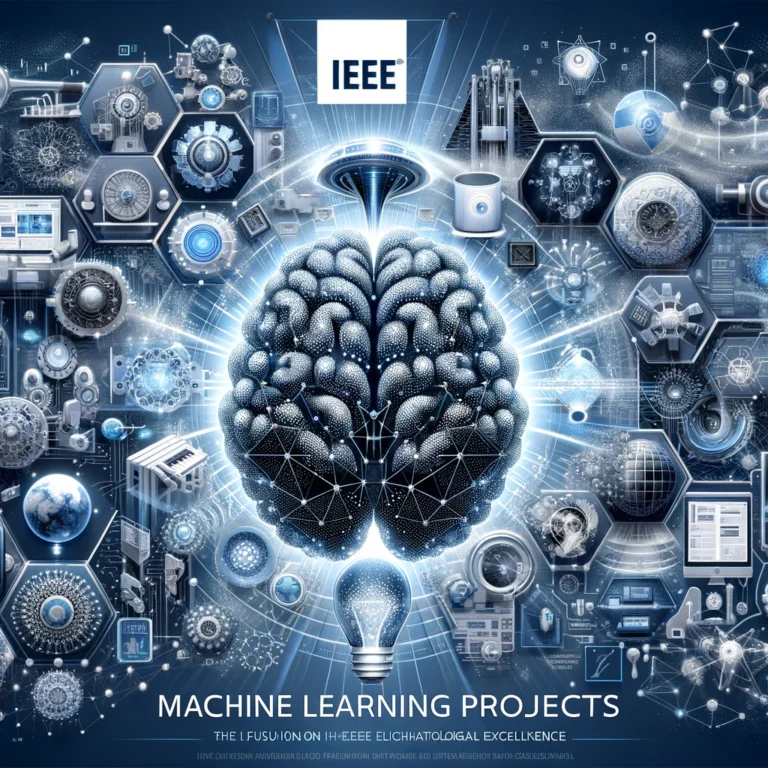Mnist Digit Classification ML Project
The MNIST Digit Classification ML project is a fantastic starting point for anyone new to machine learning. This project involves recognizing handwritten digits using the popular MNIST dataset, which is widely used for training and testing in the field of machine learning. It serves as a practical introduction to core concepts such as data preprocessing, model building, training, and evaluation, providing hands-on experience with essential techniques and tools in the machine learning pipeline. The simplicity and adequacy of the MNIST dataset make it ideal for demonstrating key machine learning concepts. Additionally, it is a standard benchmark, allowing you to compare your results with other implementations. With numerous tutorials, articles, and research papers using MNIST, finding resources and support is easy. By the end of this project, you’ll have a solid understanding of the entire machine learning workflow, invaluable for progressing to more complex datasets and models.
Exploring the Dataset: A Deep Dive into the MNIST Digit Images
The MNIST dataset training set contains 60,000 examples, while the testing set contains 10,000 examples of handwritten digits. Each example is a 28×28 pixel grayscale image. In fact, an MNIST dataset is a much smaller subset that can be received from NIST general datasets. This dataset is fundamental for machine learning projects, providing a straightforward yet comprehensive collection of digit images that are preprocessed and formatted for easy use. Its simplicity allows beginners to focus on learning the basics of machine learning without being overwhelmed by complex data preprocessing tasks. The uniformity and size of the MNIST dataset also make it ideal for training and evaluating various machine learning models, offering ample data for robust model training and performance validation.
Key Features of the MNIST Dataset:
- Size: 70,000 images in total
- Image Dimensions: 28×28 pixels
- Number of Classes: 10 (digits 0-9)
Setting Up Your Environment for the MNIST Digit Classification ML Project
Before we proceed with the project, the development environment needs to be prepared. Below are the steps:
Prerequisites:
- Python: Python should be installed on the system.
- Libraries: Install necessary libraries like TensorFlow, Keras, NumPy, and Matplotlib.
Setting up the environment correctly is crucial for ensuring that the project runs smoothly. Python, being the primary language for this project, needs to be properly installed. Additionally, several libraries are essential for handling various tasks within the project. TensorFlow and Keras are used for building and training the neural network, NumPy is utilized for numerical operations, and Matplotlib is essential for data visualization. By setting up these components, you’ll create a robust environment that supports the development and execution of your machine learning model.
pip install tensorflow keras numpy matplotlib
Data Preprocessing Techniques for the MNIST Digit Classification ML Project
Data preprocessing is among the critical tasks that need to be done before any machine learning problem. Below are the different techniques you will play around with the data for the same.
Steps to be followed:
- Normalization: Scale pixel values down to be in the range 0 to 1.
- Reshape: Reshape data to fit the required input shape of your model.
- Categorical Encoding: Convert class labels to one-hot encoded vectors.
Data preprocessing is essential for improving the performance and accuracy of your machine learning model. Normalization helps in scaling the pixel values, making the data easier to process for the neural network. Reshaping ensures that the data conforms to the input requirements of your model, facilitating smooth training and evaluation. Categorical encoding transforms class labels into a format that the model can understand, enabling effective classification of the digit images. By implementing these preprocessing steps, you set a strong foundation for building a robust and accurate digit classification model.
import numpy as np
from keras.utils import to_categorical
# Normalize the images
X_train = X_train / 255.0
X_test = X_test / 255.0
# Reshape the data
X_train = X_train.reshape(-1, 28, 28, 1)
X_test = X_test.reshape(-1, 28, 28, 1)
# One-hot encode the labels
y_train = to_categorical(y_train, 10)
y_test = to_categorical(y_test, 10)
Building a Neural Network for MNIST Digit Classification: A Step-by-Step Guide
Import Required Libraries
First, you need to import the necessary libraries that will help you build, train, and evaluate the neural network.
import numpy as np
import tensorflow as tf
from tensorflow.keras.models import Sequential
from tensorflow.keras.layers import Dense, Conv2D, Flatten, MaxPooling2D
from tensorflow.keras.utils import to_categorical
Define the Model Architecture
Next, define the architecture of your neural network. For MNIST digit classification, a common architecture includes convolutional layers followed by pooling layers and dense layers.
model = Sequential()
# Add a convolutional layer
model.add(Conv2D(32, kernel_size=(3, 3), activation='relu', input_shape=(28, 28, 1)))
# Add a max-pooling layer
model.add(MaxPooling2D(pool_size=(2, 2)))
# Flatten the output from the convolutional layers
model.add(Flatten())
# Add a fully connected layer
model.add(Dense(128, activation='relu'))
# Add the output layer with softmax activation for classification
model.add(Dense(10, activation='softmax'))
Compile the Model
After defining the architecture, compile the model. This step involves specifying the optimizer, loss function, and metrics for evaluation.
model.compile(optimizer='adam', loss='categorical_crossentropy', metrics=['accuracy'])
Train the Model
Now, train the model using the training data. The model will adjust its weights based on the error calculated during training.
# Assuming X_train and y_train are your training data and labels
model.fit(X_train, y_train, validation_data=(X_test, y_test), epochs=10)
Evaluate the Model
Finally, evaluate the model using the test data to see how well it performs on unseen data.
# Assuming X_test and y_test are your testing data and labels
loss, accuracy = model.evaluate(X_test, y_test)
print(f'Test accuracy: {accuracy}')
This detailed approach ensures that each step in building a neural network is carefully executed, from importing necessary libraries to evaluating the model’s performance on test data.
from keras.models import Sequential
from keras.layers import Dense, Conv2D, Flatten, MaxPooling2D
# Define the model
model = Sequential()
model.add(Conv2D(32, kernel_size=(3, 3), activation='relu', input_shape=(28, 28, 1)))
model.add(MaxPooling2D(pool_size=(2, 2)))
model.add(Flatten())
model.add(Dense(128, activation='relu'))
model.add(Dense(10, activation='softmax'))
# Compile the model
model.compile(optimizer='adam', loss='categorical_crossentropy', metrics=['accuracy'])
# Train the model
model.fit(X_train, y_train, validation_data=(X_test, y_test), epochs=10)
MNIST Digit Classification ML Project: Choosing the Right Hyperparameters
Hyperparameters make a very big difference when it comes to any model’s performance. Here are a couple:
Learning Rate
The learning rate controls how much to change the model in response to the estimated error each time the model weights are updated. It determines the step size during the optimization process. A small learning rate might make the training process very slow, while a large learning rate could cause the model to converge too quickly to a suboptimal solution.
Batch Size
Batch size is the number of samples per gradient update. It impacts the stability and speed of the training process. Smaller batch sizes offer a more accurate estimate of the gradient but make the training process slower. Larger batch sizes can speed up training but might lead to less stable updates.
Epochs
Epochs are the number of times the entire training dataset is passed forward and backward through the neural network. More epochs can help improve the model’s performance, but too many can lead to overfitting, where the model learns the training data too well and performs poorly on new, unseen data.
Choosing the right hyperparameters involves balancing these elements to optimize model performance. It often requires experimentation and tuning to find the optimal settings for your specific dataset and model architecture.
Training the Model: Tips and Tricks for MNIST Digit Classification
Tips:
- Use Callbacks: Implement callbacks like EarlyStopping to prevent overfitting.
- Data Augmentation: Increase the diversity of your training data.
Evaluating Model Performance in the MNIST Digit Classification ML Project
Metrics:
- Accuracy: The most common metric for classification tasks.
- Confusion Matrix: Provides a detailed breakdown of correct and incorrect classifications.
from sklearn.metrics import confusion_matrix
import matplotlib.pyplot as plt
import seaborn as sns
# Evaluate the model
loss, accuracy = model.evaluate(X_test, y_test)
# Confusion Matrix
y_pred = model.predict(X_test)
conf_matrix = confusion_matrix(y_test.argmax(axis=1), y_pred.argmax(axis=1))
# Plot Confusion Matrix
plt.figure(figsize=(10, 7))
sns.heatmap(conf_matrix, annot=True, fmt='d')
plt.xlabel('Predicted')
plt.ylabel('True')
plt.show()
Advanced Techniques: Improving Accuracy in MNIST Digit Classification
Techniques:
- Using Convolutional Neural Networks (CNNs): CNNs are highly effective for image classification tasks.
- Ensemble Methods: Combining the predictions of multiple models to improve accuracy.
Using Convolutional Neural Networks (CNNs) in MNIST Digit Classification ML Projects
CNNs are specifically designed to process data with a grid-like topology, such as images. They are highly effective for image classification tasks due to their ability to capture spatial hierarchies.
CNN Architecture:
- Convolutional Layers: Extract features from the input image.
- Pooling Layers: Reduce the dimensionality of feature maps.
- Fully Connected Layers: Perform the final classification.
MNIST Digit Classification ML Project: Debugging Common Issues
Common Issues:
- Overfitting: Use dropout layers to prevent overfitting.
- Vanishing/Exploding Gradients: Use techniques like batch normalization to mitigate these issues.
Optimizing Your Model: Techniques to Speed Up MNIST Digit Classification
Techniques:
- Hardware Acceleration: Use GPUs to speed up training.
- Model Optimization: Prune and quantize your model to reduce its size and improve inference speed.
Deploying Your MNIST Digit Classification Model into Production
Deploying a model involves making it available for real-world use. Here are the steps:
Steps:
- Export the Model: Save the trained model.
- Set Up a Server: Use frameworks like Flask or Django to create a web service.
- Integrate with an Application: Make the model accessible through an API.
# Save the model
model.save('mnist_model.h5')
# Example Flask server setup
from flask import Flask, request, jsonify
import tensorflow as tf
app = Flask(__name__)
model = tf.keras.models.load_model('mnist_model.h5')
@app.route('/predict', methods=['POST'])
def predict():
data = request.get_json()
prediction = model.predict(data['image'])
return jsonify(prediction.tolist())
if __name__ == '__main__':
app.run(debug=True)
Real-World Applications of MNIST Digit Classification Models
Applications
Handwriting Recognition
Digitizing handwritten documents is a significant application of MNIST digit classification models. These models can convert handwritten text into digital text, making it easier to store, search, and analyze large volumes of handwritten data.
Banking
Automating check handling is another crucial application. MNIST digit classification models can be used to automatically read and process handwritten checks, improving efficiency and accuracy in banking operations.
Education
In the field of education, these models can be utilized for grading handwritten exams. By automatically recognizing and evaluating handwritten answers, educators can save time and reduce manual grading errors, allowing for a more efficient assessment process.
Future Trends: What’s Next for MNIST Digit Classification ML Projects?
Trends:
- Advanced Architectures: Use of more sophisticated neural network architectures.
- Integration with Other Technologies: Combining ML with IoT and blockchain for enhanced security and functionality.
MNIST Digit Classification ML Project: A Comprehensive Case Study
Case Study
Objective
The goal is to classify handwritten digits with high accuracy.
Methods
The case study involves several steps:
- Data Preprocessing: This includes normalization, reshaping, and categorical encoding to prepare the data for model training.
- Neural Network Building: Constructing a neural network architecture suitable for digit classification.
- Training: Training the neural network using the MNIST dataset.
- Evaluation: Assessing the model’s performance on the test data.
Results
The project achieved an impressive accuracy of 99% on the test set, demonstrating the effectiveness of the methods employed.
Conclusion
The MNIST Digit Classification ML project is a foundational exercise in the area of machine learning. It encompasses various aspects, from data preprocessing to model deployment, providing a comprehensive introduction to the machine learning workflow. By meticulously following the step-by-step process outlined in this guide, you can develop robust digit classification models and gain valuable hands-on experience. This project not only enhances your understanding of key machine learning concepts but also prepares you for more advanced projects in the future. Engaging in this project allows you to effectively explore the exciting and dynamic world of machine learning, setting a strong foundation for your journey in this field.
Summary and Key Takeaways from Our MNIST Digit Classification ML Project
Key Takeaways:
- Understanding the MNIST Dataset: A foundational dataset for ML projects.
- Data Preprocessing: Critical for model accuracy.
- Neural Network Building: Step-by-step guide to creating and training a model.
- Model Evaluation: Importance of accuracy and confusion matrix.
- Advanced Techniques: Enhancing model performance with CNNs and optimization methods.












